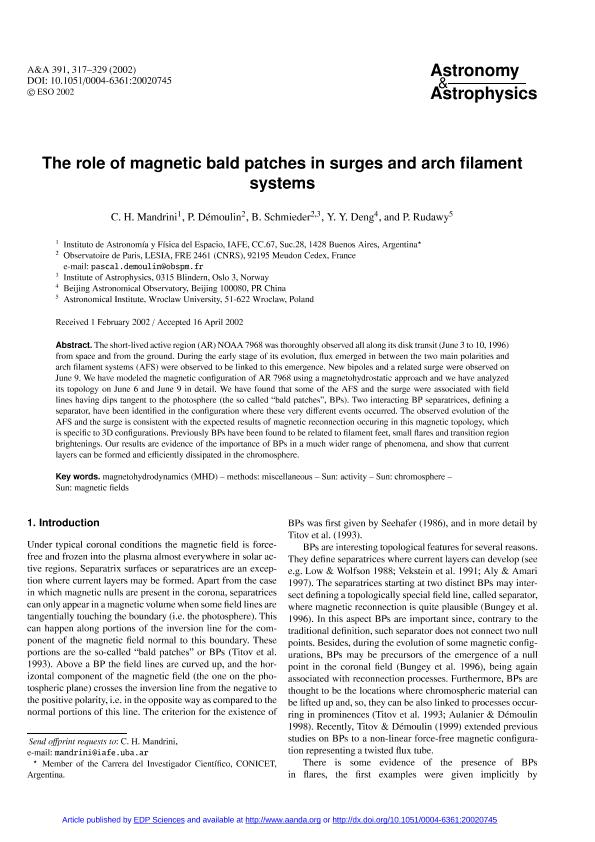Mostrar el registro sencillo del ítem
dc.contributor.author
Mandrini, Cristina Hemilse

dc.contributor.author
Démoulin, Pascal

dc.contributor.author
Schmieder, B.
dc.contributor.author
Deng, Y. Y.
dc.contributor.author
Rudawy, P.
dc.date.available
2017-08-15T15:05:08Z
dc.date.issued
2002-08
dc.identifier.citation
Mandrini, Cristina Hemilse; Démoulin, Pascal; Schmieder, B.; Deng, Y. Y.; Rudawy, P.; The role of magnetic bald patches in surges and arch filament systems; EDP Sciences; Astronomy and Astrophysics; 391; 1; 8-2002; 317-329
dc.identifier.issn
0004-6361
dc.identifier.uri
http://hdl.handle.net/11336/22448
dc.description.abstract
The short-lived active region (AR) NOAA 7968 was thoroughly observed all along its disk transit (June 3 to 10, 1996) from space and from the ground. During the early stage of its evolution, flux emerged in between the two main polarities and arch filament systems (AFS) were observed to be linked to this emergence. New bipoles and a related surge were observed on June 9. We have modeled the magnetic configuration of AR 7968 using a magnetohydrostatic approach and we have analyzed its topology on June 6 and June 9 in detail. We have found that some of the AFS and the surge were associated with field lines having dips tangent to the photosphere (the so called ``bald patches'', BPs). Two interacting BP separatrices, defining a separator, have been identified in the configuration where these very different events occurred. The observed evolution of the AFS and the surge is consistent with the expected results of magnetic reconnection occuring in this magnetic topology, which is specific to 3D configurations. Previously BPs have been found to be related to filament feet, small flares and transition region brightenings. Our results are evidence of the importance of BPs in a much wider range of phenomena, and show that current layers can be formed and efficiently dissipated in the chromosphere.
dc.format
application/pdf
dc.language.iso
eng
dc.publisher
EDP Sciences

dc.rights
info:eu-repo/semantics/openAccess
dc.rights.uri
https://creativecommons.org/licenses/by-nc-sa/2.5/ar/
dc.subject
Magnetohydrodynamics
dc.subject
Solar Activity
dc.subject
Solar Chromosphere
dc.subject
Solar Magnetic Fields
dc.subject.classification
Astronomía

dc.subject.classification
Ciencias Físicas

dc.subject.classification
CIENCIAS NATURALES Y EXACTAS

dc.title
The role of magnetic bald patches in surges and arch filament systems
dc.type
info:eu-repo/semantics/article
dc.type
info:ar-repo/semantics/artículo
dc.type
info:eu-repo/semantics/publishedVersion
dc.date.updated
2017-08-11T14:57:59Z
dc.journal.volume
391
dc.journal.number
1
dc.journal.pagination
317-329
dc.journal.pais
Francia

dc.journal.ciudad
Paris
dc.description.fil
Fil: Mandrini, Cristina Hemilse. Consejo Nacional de Investigaciónes Científicas y Técnicas. Oficina de Coordinación Administrativa Ciudad Universitaria. Instituto de Astronomía y Física del Espacio. - Universidad de Buenos Aires. Facultad de Ciencias Exactas y Naturales. Instituto de Astronomía y Física del Espacio; Argentina
dc.description.fil
Fil: Démoulin, Pascal. Centre National de la Recherche Scientifique. Observatoire de Paris; Francia
dc.description.fil
Fil: Schmieder, B.. Centre National de la Recherche Scientifique. Observatoire de Paris; Francia
dc.description.fil
Fil: Deng, Y. Y.. Beijing Astronomical Observatory; China
dc.description.fil
Fil: Rudawy, P.. Wroclaw University; Polonia
dc.journal.title
Astronomy and Astrophysics

dc.relation.alternativeid
info:eu-repo/semantics/altIdentifier/doi/http://dx.doi.org/10.1051/0004-6361:20020745
dc.relation.alternativeid
info:eu-repo/semantics/altIdentifier/url/https://www.aanda.org/articles/aa/abs/2002/31/aa2334/aa2334.html
Archivos asociados
